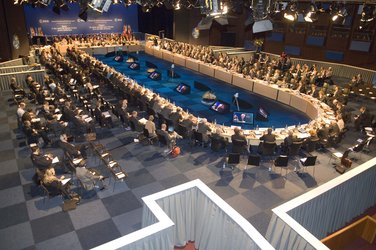Signature takes GMES to next phase
Now that the extension to the GMES Agreement between the European Commission and ESA has been signed, ESA can forge ahead and implement the second phase of the GMES Space Component with a further €205 million added to the budget.
The signature follows the go-ahead to start the second phase – Segment 2 – of the Global Monitoring for Environment and Security (GMES) Space Component that was given at the ESA Ministerial Council in November 2008. At the meeting, ESA's Member States approved a €831.4 million contribution to the programme. The subsequent amendment to the Agreement was signed on 28 January in Brussels, Belgium by ESA's Director General Jean-Jacques Dordain and Heinz Zourek the Director General of the European Commission's Directorate General for Enterprise and Industry.

The GMES Space Component includes a series of five Earth observation missions called Sentinels to provide data for services to better manage the environment, understand and mitigate the effects of climate change and ensure civil security. Each of the first three Sentinels is planned as a pair of complementary satellites to be launched successively, with the first Sentinel envisaged to be launched at the end of 2011.
The first phase of the GMES Space Component – Segment 1 – spans the 2006-2013 timeframe and focuses on the development of the first Sentinel-1, Sentinel-2 and Sentinel-3 satellites. The Sentinel satellites are being developed by ESA specifically to meet the needs of the services that will be provided through GMES. Sentinel-1 will carry an all-weather day and night radar imager for land and ocean services, Sentinel-2 will deliver high-resolution optical images for land services and Sentinel-3 will carry several instruments for ocean and global land monitoring services.
With the go-ahead for Segment 2, ESA can now start to implement the second phase of the programme, which overlaps with Segment 1 and runs through until 2018. It covers the development of the ground infrastructure, the completion of the full operational capability of the first three Sentinels to make up the pairs. In addition, provision can now be made to develop the first two atmospheric payloads Sentinel-4 and Sentinel-5 precursor. The Sentinel-4 payload will be carried on a Meteosat Third Generation-Sounder in geostationary orbit and the Sentinel-5 precursor, which will bridge the gap between Envisat and Sentinel-5, will be carried on a small dedicated platform in polar orbit.
"With the signature of this amendment to the Agreement between the European Commission and ESA, we have now received almost all of the required funding for the build-up of the space and ground infrastructure for GMES. This is good news for European citizens as GMES will provide a stream of information to improve a wide range of application areas such as emergency management, agriculture, ship routing and air-pollution monitoring, to name just a few. The next challenge will be to ensure the funding for operating the satellites which will be needed once the satellites are in orbit from the end of 2011 onwards," says Josef Aschbacher, Head of ESA's GMES Space Office.






